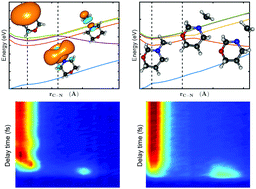Symmetry controlled excited state dynamics†
Abstract
Symmetry effects in internal conversion are studied by means of two isomeric cyclic tertiary aliphatic amines in a velocity map imaging (VMI) experiment on the femtosecond timescale. It is demonstrated that there is a delicate structural dependence on when coherence is preserved after the transition between the 3p and 3s Rydberg states. N-Methyl morpholine (NMM) shows unambiguous preserved coherence, consistent with previous work, which is decidedly switched off by the repositioning of oxygen within the ring. From the differences in these dynamics, and an examination of the potential energy surface following the normal modes of vibration, it becomes clear that there is a striking dependence on atom substitution, which manifests itself in the permitted modes of vibration that take the system out of the Franck–Condon region through to the 3s minimum. It is shown that the non Fermi-like behaviour of NMM is due to a conical intersection (CI) between the 3px and 3s states lying directly along the symmetry allowed path of steepest descent out of the Franck–Condon region. NMI, where the symmetry has been changed, is shown to undergo internal conversion in a more Fermi-like manner as the energy spreads through the available modes ergodically.



 Please wait while we load your content...
Please wait while we load your content...
